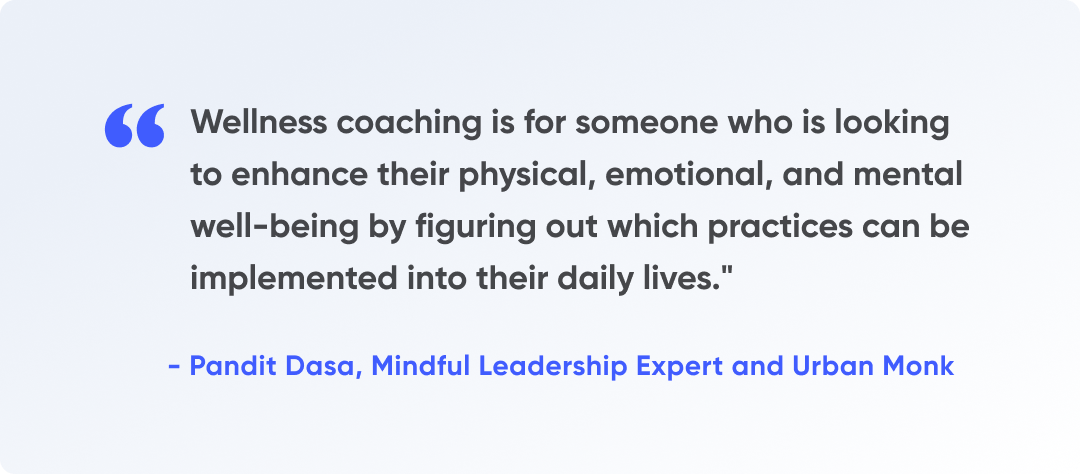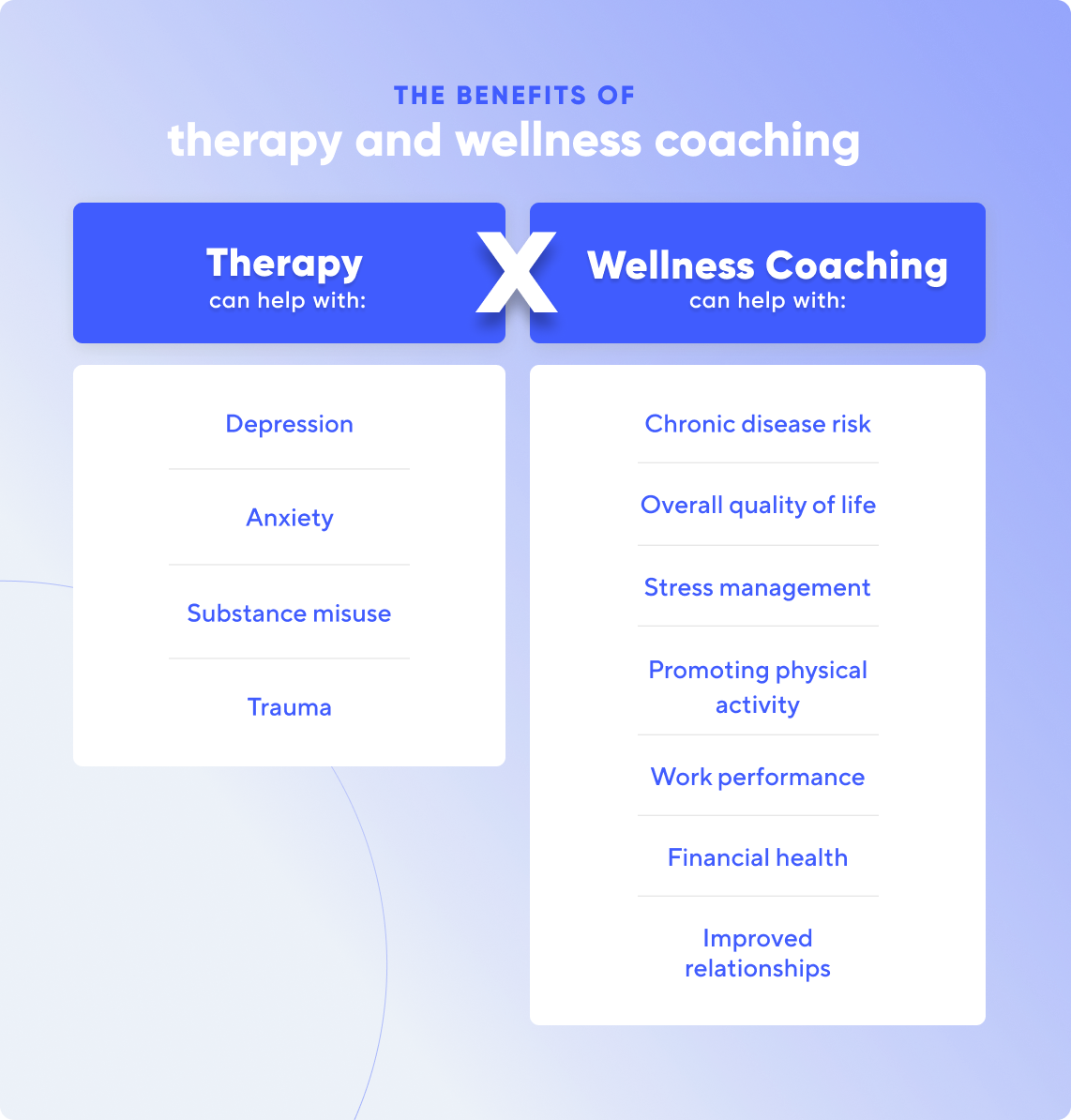When it comes to workplace benefits, there are more options to choose from than ever. This amount of variety can be a double-edged sword, however. While there is no shortage of options that support employees’ needs, identifying which ones are best for your team can be a challenge.
Consider all the choices you have for providing mental health support — flexible schedules, group workshops, new wellness-focused technology, and access to trained professionals.
Even if you’ve already determined that you want to focus on connecting employees with wellness professionals who can help improve their mental health, there are still choices to be made. Many employers find themselves deciding between wellness coaching and therapy. But what’s the difference? How do you know which type of mental health service makes the most sense for your team?
The first step is to familiarize yourself with both coaching and therapy. Read on for a breakdown of each option, a few key differences between coaching versus therapy, and advice on how to provide your team with the best benefits for their needs.
What is a therapist?
The American Psychiatric Association explains that therapy is designed to address a range of mental illnesses and other types of emotional challenges — coping with trauma, navigating relationship issues, etc. — by eliminating or managing symptoms. In short, therapy is an effective tool to help people function better in their day-to-day lives.
For individuals with certain mental illnesses, therapy is particularly effective when coupled with medication. This includes those who have depression, bipolar disorder, schizophrenia, and generalized anxiety disorder. That said, mental health medications must be prescribed by a therapist who has the proper credentials — we’ll get into that more in just a moment.
As for what therapy entails, many people envision a one-on-one session with an expert that involves talking and working through issues together. But that just scratches the surface. There are many different types of therapy. Here are a few the American Psychiatric Association outlines:
- Cognitive behavioral therapy — a type of treatment that helps people change ineffective thinking and behavior patterns,
- Interpersonal therapy — a short-term treatment that helps patients discover healthy ways to express emotions and improve their communication.
- Psychoanalysis — an intensive form of therapy that’s conducted three or more times each week.
- Supportive therapy — a type of therapy that includes guidance and encouragement to help patients develop self-esteem and manage mental health conditions.
- Animal-assisted therapy — a treatment that involves working with animals to provide comfort and help improve communication or cope with trauma.
As with therapy types, therapists themselves are both numerous and varied. According to the National Alliance on Mental Illness (NAMI), this includes psychiatrists, psychologists, clinical social workers, counselors, and mental health nurse practitioners. While each of these therapists has different qualifications, they’re similar in that their ultimate goal is to help people better manage mental health issues.
What is a wellness coach?
If you’re unfamiliar with wellness coaching, you’re not alone. It’s a newer field than therapy.
So, what exactly is wellness coaching? In an article published in the journal Global Advances in Health and Medicine, researchers explain that the goal of health and wellness coaching is to encourage positive changes that can help people achieve their self-determined goals related to well-being. Pandit Dasa, a wellness coach who specializes in mindful leadership, can offer even more clarity:
“Wellness coaching is for someone who is looking to enhance their physical, emotional, and mental well-being by figuring out which practices can be implemented into their daily lives,” Dasa explains. “This can include habits related to diet, exercise, meditation, sleep, and relationships.”
Think of it this way — wellness coaching can help bridge the gap between where you are and where you want to be.
As an article in The Washington Post explains, wellness coaching can help empower people to find motivation and develop new habits that support their mental, physical, and emotional health.

Just like with therapy, there are many different types of wellness coaching. Coaches themselves are usually categorized by the type (or types) of coaching they provide as well. This expansive list of different specializations includes:
- Mindfulness coaching
- Fitness coaching
- Personal transformation (Life) coaching
- Sleep coaching
- Stress management coaching
- Nutrition coaching
- Financial coaching
- Work performance coaching
What’s the difference between coaching and therapy?
As for what distinguishes wellness coaching from therapy, you may have noticed that wellness coaching encompasses all aspects of wellness rather than focusing solely on mental health. Coaching is also centered around providing encouragement through a technique that Harvard Health Publishing describes as “motivational interviewing.” Therapy, on the other hand, focuses on treating and, sometimes, diagnosing mental health conditions.
Therapists and wellness coaches also differ in terms of qualifications. Therapists typically must have at least a masters’ degree and the appropriate licensure, be it a medical license, a clinical social work license, or another practice-specific credential. It’s also important to recognize that only therapists who are licensed health care providers, such as psychiatrists and mental health nurse practitioners, can prescribe medications.
When it comes to wellness coaches, qualifications are more varied. It’s a good idea to search for professionals who have widely recognized credentials such as those offered through the National Board for Health and Wellness Coaching, the International Coaching Federation, and the Corporate Health and Wellness Association.
While it might seem daunting to verify a coach’s qualifications, it’s pretty simple to identify qualified professionals if you connect with them through a wellness platform that’s already vetted them. Wellness Coach uses a thorough process that takes place over three months and includes interviews and scenario training. On top of that, all coaches have received multiple degrees in their area of expertise, obtained certification from a nationally recognized program, or have devoted decades to training — and all coaches have at least five years of experience.
In terms of how effective coaching and therapy are, research shows that both methods are beneficial. But the outcomes themselves differ a bit. Therapy has been shown to help with managing mental health conditions, including depression and anxiety, substance misuse, and trauma. In comparison, research on health and wellness coaching shows it can reduce chronic disease, improve quality of life, help manage stress, and promote physical activity. Wellness coaching can also improve other aspects of your life, including work performance and your relationships. They’re both clearly good approaches to improving overall wellness.

Coaching vs. therapy: Which should you choose?
When it comes to selecting the right type of mental health professional, there’s no right or wrong answer. It all comes down to what you and your team’s needs are.
Therapists are ideal for those seeking help with a mental illness. Wellness coaches are good for those who want to achieve goals and improve their overall well-being, and they can also help to address and help build healthy habits so you can prevent feelings of stress, overwhelm, decision fatigue, and burnout.
Having trouble deciding? You don’t have to choose one or the other.
“If someone is experiencing extreme levels of depression and anxiety, wellness coaching can help; however, more professional therapy might be required for that. In such cases, wellness coaching can serve as a supplement,” Dasa explains.
It’s important to consider that many therapists are also wellness coaches who prefer to take a hybrid approach that combines both practices to best help their clients. They know the benefits of coaching and therapy and want to provide the best of both worlds.
Give your team the support they need
By now, you can see that expanding your mental health benefits doesn’t have to be a choice of wellness coaching versus therapy. You can choose wellness coaching, therapy, or both — it all depends on how expansive you want your wellness benefits to be and where your organization currently is.
If you’re starting from scratch or simply want to ensure employees have access to as many resources as possible, consider looking into an all-encompassing digital wellness platform. With this type of robust solution, you can ensure each employee is able to work toward their own goals.
Ready to take the next step? Find out what it takes to implement an effective workplace wellness program.
.png)

.svg) Share
Share.svg) Tweet
Tweet.svg) Post
Post.svg) Mail
Mail